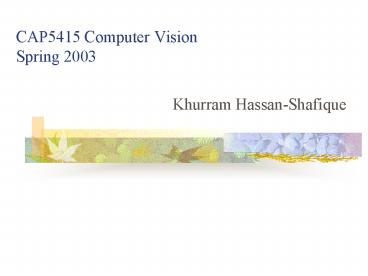CAP5415 Computer Vision Spring 2003 - PowerPoint PPT Presentation
1 / 19
Title:
CAP5415 Computer Vision Spring 2003
Description:
the noise value at each pixel is given by an independent draw from the same ... this model allows noise values that could be greater than maximum camera output ... – PowerPoint PPT presentation
Number of Views:17
Avg rating:3.0/5.0
Title: CAP5415 Computer Vision Spring 2003
1
CAP5415 Computer VisionSpring 2003
- Khurram Hassan-Shafique
2
Edge Detection in Images
- Finding the contour of objects in a scene
3
Edge Detection in Images
- What is an object?
- It is one of the goals of computer vision to
identify objects in scenes.
4
Edge Detection in Images
- Edges have different sources.
5
What is an Edge
- Lets define an edge to be a discontinuity in
image intensity function. - Edge Models
- Step Edge
- Ramp Edge
- Roof Edge
- Spike Edge
6
Detecting Discontinuities
- Discontinuities in signal can be detected by
computing the derivative of the signal.
7
Differentiation and convolution
- Recall
- Now this is linear and shift invariant, so must
be the result of a convolution.
- We could approximate this as
- (which is obviously a convolution with Kernel
- its not a very good way to do
things, as we shall see)
8
Finite Difference in 2D
Definition
Convolution Kernels
Discrete Approximation
9
Finite differences
10
Frequency Response of Differential Kernel
Fourier
Transform
Fourier
Transform
11
Noise
- Simplest noise model
- independent stationary additive Gaussian noise
- the noise value at each pixel is given by an
independent draw from the same normal probability
distribution
- Issues
- this model allows noise values that could be
greater than maximum camera output or less than
zero - for small standard deviations, this isnt too
much of a problem - its a fairly good model - independence may not be justified (e.g. damage to
lens) - may not be stationary (e.g. thermal gradients in
the ccd)
12
Finite differences and noise
- Finite difference filters respond strongly to
noise - obvious reason image noise results in pixels
that look very different from their neighbours - Generally, the larger the noise the stronger the
response
- What is to be done?
- intuitively, most pixels in images look quite a
lot like their neighbours - this is true even at an edge along the edge
theyre similar, across the edge theyre not - suggests that smoothing the image should help, by
forcing pixels different to their neighbours
(noise pixels?) to look more like neighbours
13
Finite differences responding to noise
Increasing noise -gt (this is zero mean additive
gaussian noise)
14
Smoothing reduces noise
- Generally expect pixels to be like their
neighbours - surfaces turn slowly
- relatively few reflectance changes
- Generally expect noise processes to be
independent from pixel to pixel
- Implies that smoothing suppresses noise, for
appropriate noise models - Scale
- the parameter in the symmetric Gaussian
- as this parameter goes up, more pixels are
involved in the average - and the image gets more blurred
- and noise is more effectively suppressed
15
The effects of smoothing Each row shows
smoothing with gaussians of different width each
column shows different realisations of an image
of gaussian noise.
16
Classical Operators
Prewitts Operator
Differentiate
Smooth
17
Classical Operators
Sobels Operator
Differentiate
Smooth
18
Gaussian Filter
19
Suggested Reading
- Chapter 8, David A. Forsyth and Jean Ponce,
"Computer Vision A Modern Approach - Chapter 4, Emanuele Trucco, Alessandro Verri,
"Introductory Techniques for 3-D Computer Vision" - Chapter 2, Mubarak Shah, Fundamentals of
Computer Vision































